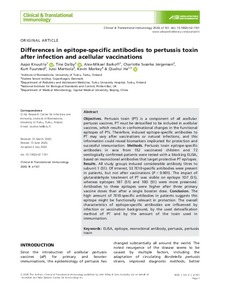Differences in epitope-specific antibodies to pertussis toxin after infection and acellular vaccinations
Aapo Knuutila; Tine Dalby; Alex-Mikael Barkoff; Charlotte Sværke Jørgensen; Kurt Fuursted; Jussi Mertsola; Kevin Markey; Qiushui He
https://urn.fi/URN:NBN:fi-fe2021042823242
Tiivistelmä
Objectives:
Pertussis toxin (PT) is a component of all acellular pertussis
vaccines. PT must be detoxified to be included in acellular vaccines,
which results in conformational changes in the functional epitopes of
PTs. Therefore, induced epitope-specific antibodies to PT may vary after
vaccinations or natural infections, and this information could reveal
biomarkers implicated for protection and successful immunisation.
Methods:
Pertussis toxin epitope-specific antibodies in sera from 152
vaccinated children and 72 serologically confirmed patients were tested
with a blocking ELISA, based on monoclonal antibodies that target
protective PT epitopes.
Results:
All study groups induced considerable antibody titres to subunit 1
(S1). Of interest, S3 7E10-specific antibodies were present in
patients, but not after vaccinations (P < 0.001). The impact
of glutaraldehyde treatment of PT was visible on epitope 1D7 (S1),
whereas epitopes 1B7 (S1) and 10D (S1) were more preserved. Antibodies
to these epitopes were higher after three primary vaccine doses than
after a single booster dose.
Conclusion:
The high amount of 7E10-specific antibodies in patients suggests
this epitope might be functionally relevant in protection. The overall
characteristics of epitope-specific antibodies are influenced by
infection or vaccination background, by the used detoxification method
of PT and by the amount of the toxin used in immunisation.
Kokoelmat
- Rinnakkaistallenteet [27094]
